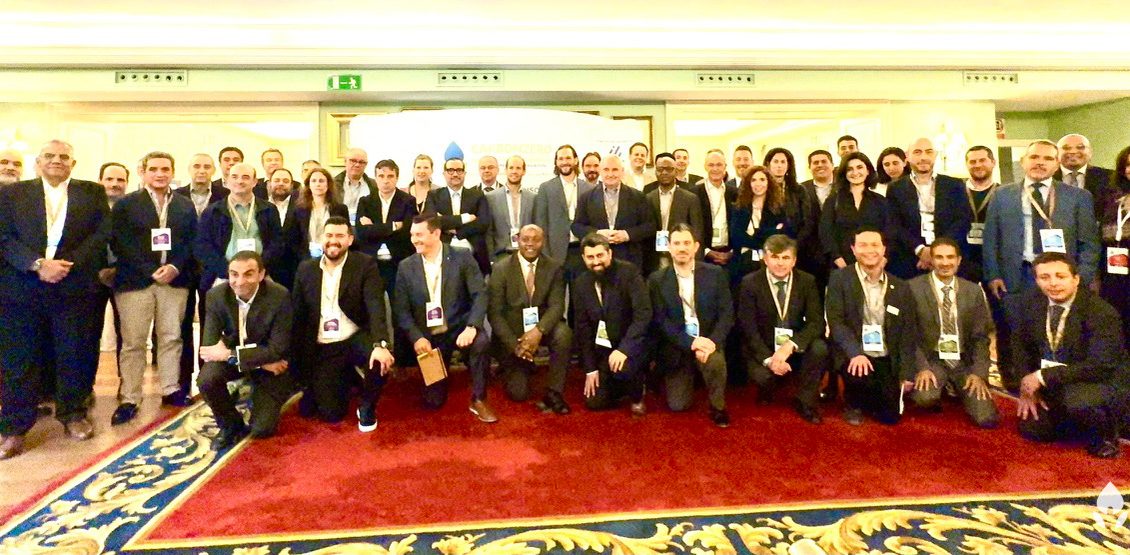
Conclusions from the most innovative conference on decarbonization by using alternative fuesl and alternative raw materials are clear: financing green solutions and the implication of all stakeholders is essential for lowering the emmissions footprint of cement and construction, one of the heaviest polluters sectors.
CarbonZero: Alternative Fuels and Raw Materials Global Conference and Exhibition 2024, organized by Industry Link on October 10-11 2024 in Spain, concluded with resounding success after two days of rich discussions, groundbreaking ideas, and actionable strategies to decarbonize the cement and construction industries. Hosted at the Wellington Hotel & Spa in Madrid, the event drew leaders, policymakers, and innovators from five continents—including representatives from Pakistan, DR Congo, Nigeria, Romania, Belgium, France, Germany, Finland, Sweden, Norway, Brazil, Spain, Italy, Portugal, United Kingdom, Mexico, and the USA—who collectively explored solutions for reducing carbon emissions and accelerating the industry’s path to net-zero.
Dive into our calendar of events, featuring CarbonZero Global Conference and Exhibition: Alternative Fuels and Raw Materials 2025 taking place in October in Bucharest, Romania; Women in CemCo International Congress Americas 2025, taking place in April in Atlanta, USA and Women in CemCo International Congress EMEA 2025, taking place in October in Bucharest, Romania; Cementitious Materials International Congress Americas 2025, taking place in April in Atlanta, USA and Cementitious Materials International Congress EMEA 2025, taking place in June in Cairo, Egypt; and Sustainability and ESG International Summit 2025 taking place in June in Cairo, Egypt.
Day 1: Innovation, Alternative Fuels, and Decarbonization Strategies
Setting the Stage for Change: Industry Leadership and Decarbonization Goals
The conference opened with a keynote address by Beatrice Ene, Managing Director at Industry Link, who underscored the cement sector’s crucial role in mitigating climate change and called for immediate, impactful action to curb its carbon footprint. Peter P. Breithaupt, Scientific Officer at the European Commission’s Innovation Centre, then presented the EU’s commitment to industrial decarbonization through the European Innovation Centre for Industrial Transformation and Emissions (INCITE), underscoring how funding and innovation are accelerating carbon-neutral advancements in cement, iron, and steel.

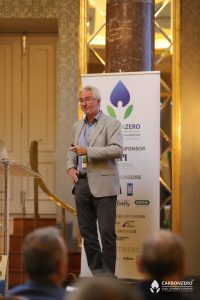
Following, Aniceto Zaragoza Ramírez, Director General of Oficemen, detailed Spain’s “5Cs Approach” to emissions reduction, a collaborative model uniting stakeholders across production and construction sectors. The necessity of sustainability transparency was addressed by Tien Peng, Co-founder of Greenplum Street LLC, who highlighted the role of Life Cycle Assessments (LCA) and Environmental Product Declarations (EPD) in setting rigorous, actionable benchmarks despite existing data challenges.
Efficiency and Innovation: Reducing Carbon Emissions in Cement
Technological innovation was a focal point as Joel Maia, CEO Europe at FCT Combustion, presented advanced strategies for “Reducing CO₂ Emissions in Cement and Clinker Production.” Maia emphasized the significant impact of enhancing operational efficiency, noted that optimizing plant controls, reducing false air intake in pre-calciners, and improving combustion can lead to CO2 reductions. A 3% efficiency improvement could save 47,000 tons of CO2 annually.
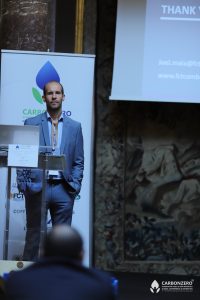
Building on this theme, Thierry Delvaux, Managing Director of Mac Valves, highlighted that by implementing advanced dust collector technologies, energy consumption could be reduced by up to 60%. “This isn’t just theory; our clients in the field report tangible savings and lower CO2 emissions due to these technologies,” he added.
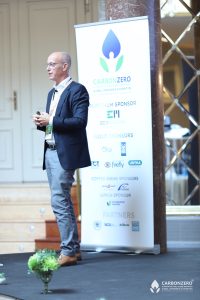
Eric Schimpf, Global Key Account Manager at Qlar, further underscored the potential of Qlar’s solutions to drive decarbonization in the cement industry. He outlined several strategies for green cement production, including the use of alternative fuels, lowering clinker factor and coal dust rates, capturing CO₂ emissions, and optimizing yard management through Qlar’s LOGIQ system.

Raúl Moreno, Director for Latin America, Spain & Portugal at Firefly AB, presented how proactive fire prevention systems can prevent significant CO₂ emissions. Moreno highlighted Firefly’s advanced solutions, such as spark detection and rapid suppression systems, designed to mitigate fires before they lead to extensive damage and emissions.
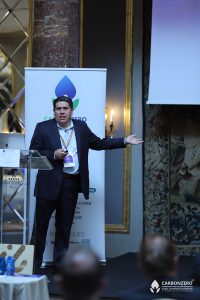
Alternative Fuels: Opportunities and Challenges
The afternoon session of CarbonZero 2024 delved into the potential of alternative fuels to drive decarbonization in cement production. Maged Moustafa, COO of Arabian Cement Company, opened by examining the logistical and financial aspects of transitioning to alternative fuels. He noted that while biomass and waste materials offer promising emissions reductions, they come with challenges related to supply chain reliability and cost management. Following him, Suleiman Akilu, BUA Cement representative shared BUA’s approach to using agricultural waste as fuel. Akilu highlighted how this strategy not only lowers emissions but also supports local economies by creating jobs and fostering sustainable practices.


Ahsan Anis, COO of Power Cement, emphasized the transformative potential of converting agricultural byproducts like rice husks and groundnut shells into fuel for cement kilns. His insights highlighted how these alternative fuels could bridge the gap between energy demands and emission reduction targets, showcasing the practicality and environmental benefits of such initiatives. Concluding the session, Carlos Roberto Escobar, Manager of Proverde at Cementos Progreso, discussed how co-processing waste addresses pressing waste management challenges. He detailed how integrating waste into cement production significantly reduces methane and CO2 emissions. Escobar underscored the environmental and economic advantages of this approach, noting its role in decreasing landfill use while optimizing cement production processes.


Key Innovations and Strategies in Cement Decarbonization
As the day continued, attention turned to the role of leadership and entrepreneurship in driving sustainable innovation. Murat Sela, CEO of OYAK Çimento, and Berkan Fidan, CTO of Cimpor Global, delivered a compelling joint presentation on the impact of industrial entrepreneurship in the fight against climate change. They underscored the urgent need for cement decarbonization and introduced promising practices, such as integrating calcined clay into cement production—a significant step toward a more sustainable industry.
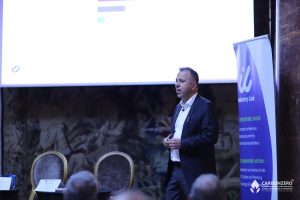
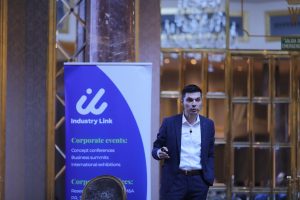
Following this discussion, Penelope Le Menestrel, Breakthrough Energy Manager for Europe, outlined forward-thinking strategies for decarbonizing cement. In her presentation, she spotlighted two crucial strategies: electrification and material innovation. Le Menestrel’s vision for the future of cement production painted an optimistic picture of what’s possible through cutting-edge advancements.

The day wrapped up with an engaging panel discussion on carbon reduction strategies, moderated by Beatrice Ene. Panelists included Alfredo Carrato, Venture Capital Advisor at CEMEX Ventures; Fabio Bernareggi, Business Unit Manager – WHR at the CTP Team; and Eugen Becker, Business Development Manager at Eggersmann Recycling Technology. They shared their latest developments and innovations, enriching the conversation with their diverse perspectives.

As Day 1 wrapped up, attendees gathered for a relaxed cocktail hour, offering a valuable networking opportunity to connect and reflect on the day’s insights. With a mix of fresh perspectives and shared ambitions, the gathering reinforced a hopeful outlook: while challenges remain, the cement industry’s path forward holds real promise, powered by innovation and collaboration for significant carbon reductions.
Day 2 Highlights: Market Trends, Emissions Trading, CCUS Innovations, and Green Cement Financing
Exploring the Role of Supplementary Cementitious Materials
Day 2 opened with a keynote from Grant Quasha, Chairman of Eco Material Technologies and the event’s Platinum Sponsor. He spotlighted the importance of Supplementary Cementitious Materials (SCMs) like fly ash and slag in reducing emissions and responding to the rising demand for greener building materials. Quasha emphasized that utilizing SCMs is essential for lowering the carbon footprint of cement, especially as environmental concerns gain traction in the industry.

Regulatory and Strategic Approaches to Decarbonization
The day’s sessions shifted to regulatory, legislative, and finance approaches that can help decarbonization initiatives. Miguel Ángel Sanjuán from the Spanish Institute of Cement and its Applications highlighted the standardization of coal bottom ash as a new cement constituent, demonstrating its potential to reduce clinker usage while maintaining product quality. Abdulhamit Akçay, the Vice Chairman of Turkish Cement, discussed Turkey’s crucial involvement in the global cement industry. With 21 million tons exported in 2023, Turkey is the world’s second-largest cement exporter. However, this output accounts for around 11% of the nation’s overall emissions. Akçay outlined a thorough decarbonization strategy for the Turkish cement sector, concentrating on seven important strategies: improving thermal efficiency, employing alternative fuels, lowering the clinker-to-cement ratio, decarbonizing electricity, boosting material efficiency, promoting recarbonation, and advancing carbon capture, utilization, and storage (CCUS) technologies.


Advancing CCUS Technologies in Europe
A highlight of the morning was a panel discussion on Carbon Capture, Utilization, and Storage (CCUS), featuring Víctor García-Brosa, Vice-President of Oficemen; Marta González, Head of Commercial CCS Europe and North Africa at Repsol; Fernando Impuesto Nogueras, Business Development and Diversification Director at Enagas; and Diego Novoa, CCUS Technical Manager for VC Europe, Africa & Asia. Expertly moderated by Pedro Mora, President of PTECO2, the session brought together these industry leaders to explore the state of CCUS technologies in Europe and discuss the infrastructure and investment needed to scale these solutions. In this session, experts acknowledged that “while CCUS offers promising potential, challenges such as high costs and complex infrastructure requirements continue to hinder large-scale deployment,” a sentiment echoed by several panelists and attendees.

Challenges in Hard-to-Abate Sectors
Thomas Schroder from EDF Trading continued the conversation by addressing the challenges and opportunities for achieving net-zero emissions in hard-to-abate sectors like cement, steel, and chemicals. Schroder noted that “the difficulty in these sectors lies in the high-temperature processes that are required, making fuel-switching more complex.” His presentation was followed by Sebastian Manhart of Carbonfuture, who highlighted the emerging trends in the Carbon Dioxide Removal (CDR) market, remarking that “CDR represents the next frontier in achieving net-zero, as it goes beyond just reducing emissions and starts addressing the existing carbon in the atmosphere”.
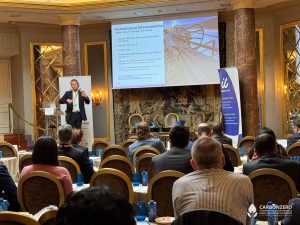

Navigating Policy Shifts in the Cement Industry
In the afternoon, the conference shifted its focus to policy frameworks influencing the industry. Joe Harder, Managing Director of One Stone Consulting, presented on “Clay Calcination Trends and Outlook 2035”, offering a glimpse into the future of this supplementary material and its role in reducing CO2 emissions. This insight was followed by Marta Diez, CBAM Consultant at Redshaw Advisors, who delivered a session on “The Effect of CBAM (Carbon Border Adjustment Mechanism) on the Cement Industry”, explaining how the policy will “impose carbon costs on cement imports into Europe, thereby encouraging local producers to adopt greener practices faster.”

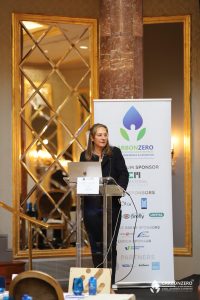
The day continued with Luyue Tan from the London Stock Exchange Group, who reviewed upcoming changes to the EU Emissions Trading System (EU ETS) and how these changes will affect cement producers. Tan stated that “the revisions to the EU ETS are designed to make the system more robust, ensuring that industries such as cement continue to reduce their carbon emissions year on year”
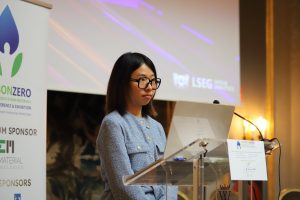
Investing in Tomorrow: Financing Green Cement
The final afternoon sessions shifted the focus towards financing mechanisms for green cement. Femi Akinrebiyo, Global Manager of Manufacturing & Trade Supplier Finance at the International Finance Corporation (IFC), discussed strategies for scaling financing to support the decarbonization of construction materials in emerging markets. Akinrebiyo highlighted that “access to affordable financing is crucial for emerging markets to adopt green technologies, and without significant investment, many of these regions will struggle to keep up with decarbonization targets.”
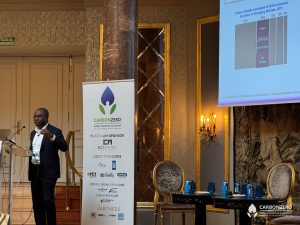
The day concluded with a panel discussion on financing green cement initiatives, moderated by Eyad Alenani, Business Development Analyst at Industry Link. The panel included industry leaders Isabel Garro, CSO of Votorantim Cimentos, Europe, Asia & Africa; Femi Akinrebiyo (IFC), and Luyue Tan (London Stock Exchange Group). Together, they explored various financing mechanisms, including green economy equities, impact investing, as key drivers in accelerating the transition to a low-carbon economy within the cement sector. Isabel Garro pointed out the significant costs involved in establishing carbon capture facilities, citing that even one such facility could cost as much as $350 million. Despite these financial challenges, she noted that collaboration with financial institutions could ease the burden by providing project preparation funds and technical support. Akinrebiyo stated that to catalyze decarbonization effectively, companies must have access to the right financing tools, and policymakers must align incentives with sustainability goals. Tan highlighted how upcoming changes to the EU Emissions Trading System (EU ETS) would directly affect the competitiveness of cement producers, thus necessitating innovative financial strategies.
Charting the Way Forward: A Commitment to Sustainable Progress
As the CarbonZero Global Conference and Exhibition 2024 conclusion, it becomes evident that the journey toward a sustainable future is not a solitary endeavor, but a collective mission fueled by collaboration and innovation. This event not only showcased cutting-edge strategies for reducing CO2 emissions in the cement and construction industries but also fostered a collective commitment among professionals to drive meaningful change. Industry Link has once again demonstrated its role as a catalyst for progress, rallying industry leaders around a shared vision for decarbonization.
The discussions at CarbonZero 2024 illuminated the vital need for strategic investments in technology, the development of local supply chains for alternative fuels, and robust regulatory support. While challenges remain, the potential benefits underscore the urgency of our mission. Looking ahead, it is essential to harness the momentum generated at CarbonZero 2024, transforming insights into action and collaboration into tangible results. The dialogue initiated at this year’s conference will seamlessly continue into the upcoming CarbonZero 2025 edition, ensuring that the drive towards sustainability remains strong.
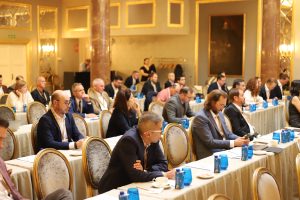
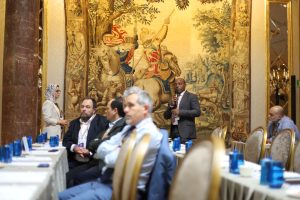
The insights gained at the event will also serve as a foundation for continued dialogue at future events, including the Sustainability & ESG International Summit, scheduled for December 11-12 in Portugal, will offer a dynamic platform for exploring the latest trends, strategies, and innovations in environmental, social, and governance practices. Additionally, the Cementitious Materials International Technical and Trade Congress 2025 will present a unique opportunity to explore advancements in cementitious materials. From ashes and slags to artificial and natural pozzolana, fumes, clays, and construction and demolition waste, this congress will spotlight the alternative raw materials shaping the future of the industry.
The journey toward sustainability is ongoing, and with a united approach and a relentless spirit of innovation, a legacy of environmental stewardship can be established for future generations.
Industry Links wishes to thank our sponsors : Eco Material Technologies, Firefly Ab, Untha Shredding Technologies, Qlar, FCT Combustion, MAC Valves, Peakward Enterprises, CrossWrap, Votorantim Cimentos and our event supporters: ZKG Magazine, AUCBM, BIBM, World Cement Association.
Subscribe to our newsletter and follow our LinkedIn page to be the first to find out about the next edition of the leading event.


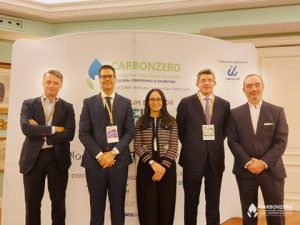

Testimonials:
“I had the honor to participate in this event, it was perfect in all aspects. – COO, Arabian Cement
‘An event with a remarkable spirit of knowledge sharing and best practices exchange!’ – Country Manager Spain/Portugal, Italy, Environmental Markets Consultant, Redshaw Advisors
“ I gathered with industry leaders in Madrid as part of the 2024 Hashtag#CarbonZero conference to better understand where the industry stands and what role CDR can play in decarbonising it.
It was so refreshing to attend an event where I did not know anyone, and where almost no one had heard of CDR” Senior Policy Advisor, Carbonfuture
“the CARBONZERO Global conference has concluded. It was one of the most interested conferences that I ever attended. So I have to congratulate to the organization for being able to gather many role players in the same spot.
During two intensive days we have shared a lot of different points of view with a large lessons learned for trying to reach the ambitious Carbon Zero at 2050 in the cement industry” International Busienss Development Manager, Loesche
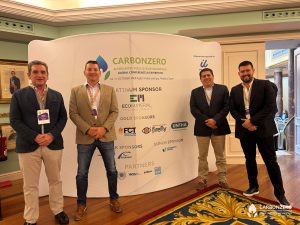
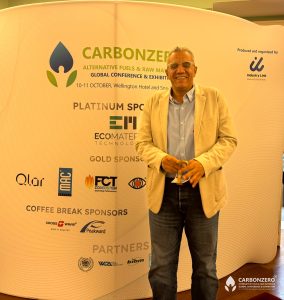





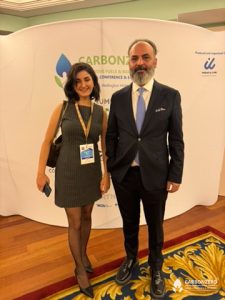
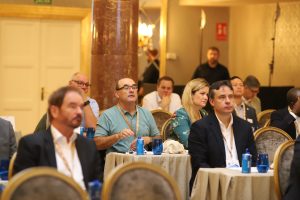
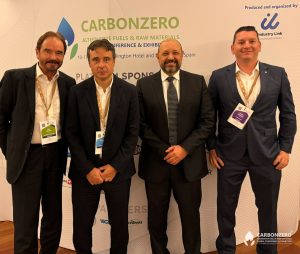

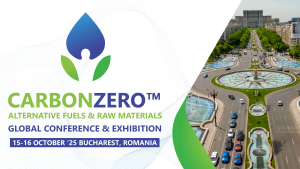



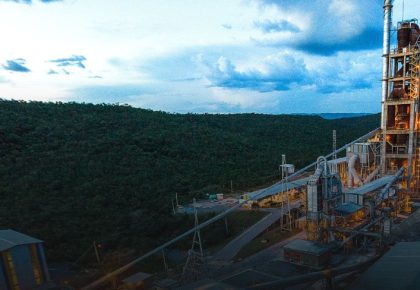


[…] can find an overview of the Madrid 2024 edition of CarbonZero here: [Link] registrations are available at contact@industrylink.eu and using the discount code GrantQ10 you […]
Comments are closed.